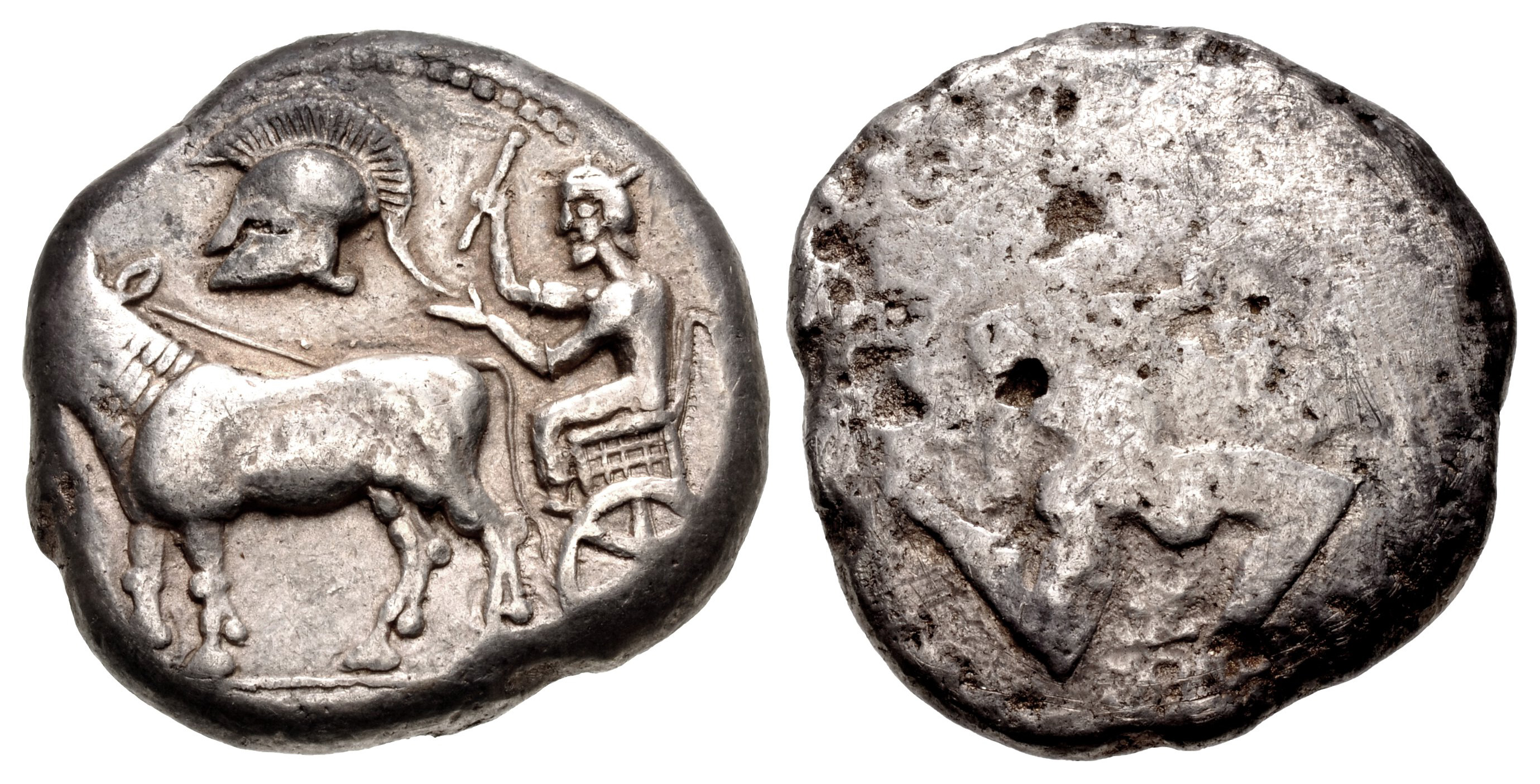S 1733 - Pangaion (uncertain mint) (Derrones), silver, dodecadrachms (480-460 BCE)
From SILVER
480 BCE - 460 BCE Silver 25,542 kg
Description
| ObverseInscription or printing placed on the obverse.: | Driver, holding goad in right hand, driving ox cart left, above, crested Corinthian helmet left |
| ReverseInscription or printing placed on the reverse.: | Clockwise triskeles, palmette between legs, [all within incuse square] |
Mint and issuing power
| MintIdentifies the place of manufacture or issue of a numismatic object.: | Pangaion (uncertain mint) | Ancient regionAncient region.: | Macedon | Modern countryModern country: Greece | AuthorityIdentifies the issuing power. The authority can be "pretended" when the name or the portrait of X is on the coin but he/she was not the issuing power. It can also be "uncertain" when there is no mention of X on the coin but he/she was the issuing power according to the historical sources: | Derrones, Thraco-Macedonian tribes |
Chronology
| FromIdentifies the initial date in a range assigned in a numismatic context. | 480 BCE | toIdentifies the final date in a range assigned in a numismatic context.. | 460 BCE | PeriodTime period of the numismatic object.: Classical 480-323 BC |
Physical description
| MetalThe physical material (usually metal) from which an object is made.: | Silver |
Median weightMedian of the weights of numismatic objects (in grams). in grams | 38.90 | DenominationTerm indicating the value of a numismatic object. Examples: tetradrachm, chalkous, denarius.: | dodecadrachm | StandardStandard.: | Thraco-Macedonian |
Image

S1733 Derrones dodecadrachms helmet.jpg [1]
References
| Die study referencePublication of the study: | Tzamalis 20121Tzamalis 2012, p. 42-80 | ||
| Coin series referenceReference to coin series study: | Sear I2Sear I, n° 1315, HGC 3.13HGC 3.1, n° 279-280 | ||
Obverse dies distribution
| FrequencyFrequency of specimen in distribution. ᵖ | Number of obversesNumber of obverse dies. ᵖ (o) | % (o) | Number of coinsNumber of coins. (n) | % (n) | Die nameName(s) of the die(s). |
| 1 | 7 | 23.33 | 7 | 4.29 | 4, 12, 15, 20, 22, 25, 27 |
| 2 | 3 | 10 | 6 | 3.68 | 13, 26, 30 |
| 3 | 3 | 10 | 9 | 5.52 | 9, 16, 24 |
| 4 | 3 | 10 | 12 | 7.36 | 2, 5, 6 |
| 5 | 3 | 10 | 15 | 9.2 | 11, 21, 29 |
| 6 | 2 | 6.67 | 12 | 7.36 | 17, 19 |
| 7 | 2 | 6.67 | 14 | 8.59 | 18, 23 |
| 8 | 2 | 6.67 | 16 | 9.82 | 1, 10 |
| 10 | 1 | 3.33 | 10 | 6.13 | 28 |
| 12 | 1 | 3.33 | 12 | 7.36 | 8 |
| 13 | 1 | 3.33 | 13 | 7.98 | 14 |
| 18 | 1 | 3.33 | 18 | 11.04 | 3 |
| 19 | 1 | 3.33 | 19 | 11.66 | 7 |
| Total | 30 of 30 | 99.99 | 163 of 163 | 99.99 |
Reverse dies distribution
no distribution is available
Quantification
| Number of obversesNumber of obverse dies. ᵖ (o) | 30 | Number of singletons (o1)The number of singleton coins. ᵖ | 7 |
| Number of reverse diesNumber of reverse dies. (r) | 31 | Number of coinsNumber of coins. (n) | 163 |
| Coins per obverse dieNumber of coins per obverse die. (n/o) | 5.43 | Coins per reverse dieNumber of coins per reverse die. (n/r) | 5.26 |
| Reverse per obverse ratioRatio of obverse dies divided by reverse dies. (r/o) | 1.03 | Percentage of singletons (o1)number of coins (n) divided by the number of singletons (o1) ᵖ | 23.33 % |
| Original number of dies (O) (Carter 1983 formula)The estimation of the number of coins according to Carter 1983 ᵖ | 32.83 | Coins struck if 20,000 as average productivity per dieCoins made if the average productivity for obverses (according to Carter) is 20,000. ᵖ | 656,600 |
| Original number of dies (O) (Esty 2011 formula)The estimation of the number of coins according to the singleton formula in Esty 2011 ᵖ (O) | 36.77 | Survival rate if 20,000 as average productivity per dieSurvival rate if average productivity is 20,000. ᵖ | 0.00025 |
| Coverage (o = % of O) (Esty 1984 formula)Esty 1984 - coverage (% of O) ᵖ (o = % of O) | 95.71% | Die productivity if survival rate 1/2,000Average productivity if survival rate is 1/2,000. ᵖ | 9,929.94 |
| Weight of silver (in kg) if 20,000 coins per die (O = Carter formula)Carter 1983 * Median weight * 20000 (*10 if gold or electrum) ᵖ | 25,542 kg <br /> 25,542 kg | Die productivity if survival rate 1/5,000Average productivity if survival rate is 1/5,000. ᵖ | 24,824.86 |
Remarks
Likely military